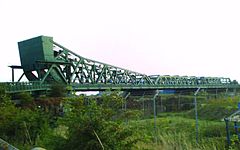Keadby Bridge
| Keadby Bridge | |
| Lincolnshire | |
|---|---|
 Keadby Bridge | |
| Location | |
| Type: | Bascule bridge |
| Carrying: | Double track railway; two-lane road |
| Crossing: | River Trent |
| Location | |
| Location: | 53°35’9"N, -0°43’52"W |
| Structure | |
| Length: | 548 ft Main span: 150 ft |
| Type: | Bascule bridge |
| History | |
| Built 1916 | |
| Architect: | Alfred Charles Gardner |
| Information | |
Keadby Bridge, more formally known as the King George V Bridge, crosses the River Trent near Althorpe and Keadby in Lincolnshire. It was designed by Alfred Charles Gardner FRSE MIME.[1]
History
The Lincolnshire Echo reported that the first passenger train to cross the new bridge left Althorpe Station at 10:35am on 21 May 1916. The train was driven by Herbert Duke of Mexborough and on the invitation of Sir Sam Fay, Joshua Slowan of Barnetby, who had driven the first passenger train across the old bridge, rode on the engine.[2]
This Scherzer rolling lift bridge carries both road and rail traffic across the River Trent. It was built between 1912 and 1916 by the Great Central Railway to replace a previous swing bridge built by the South Yorkshire Railway and opened in 1864.[3] It carries a double track railway line on the southern side, and the two-lane, single carriageway A18 road on the north side.
Its 163-ft electrically powered bascule (lifting span) was one of the first of its type in Britain and when built, was the largest in Europe. Designed by James Ball and C A Rowlandson and built by contractors Sir William Arrol & Co. it has three main spans and two approach spans. The eastern main span was the one that lifted. The Scherzer bascule rolled and rotated on counterbalance. It was electrically powered, originally by a large storage battery fed by petrol-driven generators housed in the engine room beneath the east approach span.[4] This was later modified to mains electricity.
The bridge has not been lifted since 1956. The bridge was widened and the headroom increased in 1960 and the bascule was fixed in position.[5]
Gallery
-
Plaque on Keadby Lifting Bridge regarding its opening on 21 May 1916
-
Keadby Bridge, from Althorpe Railway Station
-
Keadby Bridge from upstream east bank.
References
- ↑ Proceedings of the Institution of Civil Engineers: May 1953: obituaries
- ↑ Lincolnshire Echo, Monday 22nd May 1916
- ↑ Manchester Times, Saturday 21 May 1864
- ↑ Proceedings of the Institution of Civil Engineers, volume 203 (1916-17).
- ↑ Civil engineering heritage: Eastern and central England. E. A. Labrum


